-
Posts
3,850 -
Joined
-
Last visited
Content Type
Profiles
Forums
Store
Help Articles
Posts posted by Shalmanese
-
-
My advice is to use as much chocolate as you can get your hands on, the extra thermal mass and room for dipping makes the process so much easier. Anything you have left over you can cool again for use another day.
-
It's a massive boondoggle. Nearly all the farm subsidies go to a few, select large producers who then use this money for intense lobbying and PR to continue the subsidies. Meanwhile, the average American (and european) consumer has images of idyllic family farms and the need to keep food supplies secure.
Farm subsidies have probably one of the most distorting effects on world trade and if the western world had any scruples, they would get rid of them immediately.
FTR: Europe is a lot worse on subsidies that the US and seems to be more stubborn about keeping them.
-
Plate haphazardly
Take picture
If it looks good, post in the Dinner thread
If it looks bad, post in the Dinner II thread.
-
Heh, that's funny. I actually tried using an (old) electric kettle to reduce stock since it evaporates so much faster. However, I could never get the foaming under control so it would always spill over. Didn't seem to have damaged the kettle though.
-
Chicken & Chips!
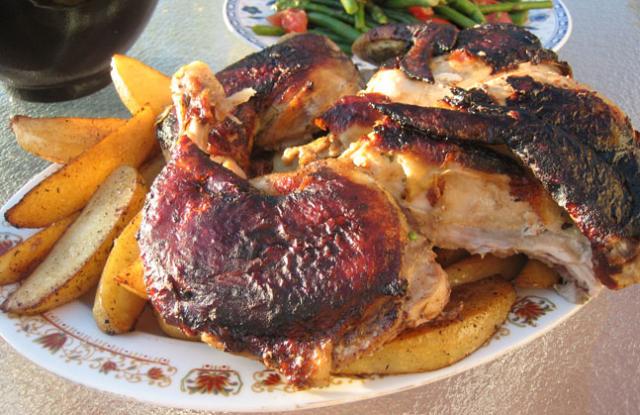
It's chicken under a brick. I got the recipe from America's Test Kitchen. The potatos are infused with a lovely schmaltzy flavour! beautiful.
For a sauce...
[massive food geek]
I must be the only person in the entire WORLD to have ever served Veloute three ways


 .
.[/massive food geek]
Accompanied with an Asparagus, Green Bean and Tomato Salad:
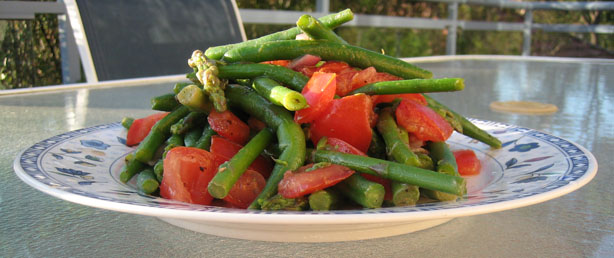
Whisked some leftover chicken fat with some red wine vinegar, salt & pepper. Tossed in a bit of the pan drippings... mmm...
edit: For dessert, slices of juicy sweet watermelon, first of the season. Yum!
And for the balcony deprived among you:


-
No, you can't. I used to make 'dry' roux all the time. Flour has a trace amount of fat. By toasting it in this fashion, you're accelerating the oxidation process. Although it's fine to cook with immediately, if you stick it in a jar in your cupboard for a few days it will be rancid the next time you use it. Nothing's worse than spending a half hour (or more) on a sauce only to find out you used rancid roux.
Interesting, I didn't know that. One site says baked flour can keep for 6 or more months. Might the level of refinement have something to do with it? Diffferent white flours contain different amounts of the wheat germ. Maybe using a very highly refined flour would slow the process down.
One huge player in the wet vs. dry roux game is the conductivity of fat. Fat conducts the heat in such a way that all the flour particles, with careful stirring, are being toasted evenly. With dry roux, oven or pan, you can stir until your arm just about falls off and you won't get the even toasting you get with fat. That even toasting plays a huge role down the line in consistency and taste.If you have a look at the pictures, oven baked flour is remarkably regular in browning. I couldn't spot any variation at all. Pan toasting might be different.
-
I had two friend who happened to have birthdays within a week of each other and they are both committed chocholics so I decided to be a bit sneaky and make some homemade chocolate truffles for both and make them think I did it just for them
 .
.Anyway, I made 4 different varieties:
Dark chocolate and lime juice infused with mint, coated in a dark chocolate shell and rolled in toasted coconut
Dark Chocolate, navel orange juice & cointreu coated in dark chocolate and rolled in cocoa powder
White chocolate & passionfruit juice coated in white chocolate
White chocolate & toasted ground almonds coated in white chocolate and rolled in toasted flaked almonds
I made them a bit bigger than the ones in the demo, about 3cm each or the width of 2 fingers. The only problem was that I didn't take into account the juice for the ganache so they were quite a bit softer than I would have liked. This made them really difficult to roll.
In retrospect, I probably should have started off doing a relatively firm ganache and only tried doing softer ones as I gained some experience. I didn't think to air dry the ganache overnight which might have also helped. Also, I didn't have enough chocolate at the end and tempering was a pain since the chocolate hardened very quickly. It would have been better to use more chocolate and then chill what I didn't use and store.
But reports from both parties indicated that the chocolates were a success so thats good. Strangely enough, standing around chocolate all day was a surprising appetite suppresant. I started work at 10am and I didn't feel hungry until 7pm when I was heading to the birthday party.
-
I don't think you can even buy non-electric kettles anymore in Australia unless you want shiny display pieces. Electric kettles are useful for so much more than just tea. You can get water boiling for pasta or blanching vegtables so much faster than on the stovetop. I nearly always start a kettle of water boiling before I start cooking and I almost always use up nearly all of it by the end.
If your buying a kettle, make sure to get one with a contactless base. If you don't use it too often, then you can stash the kettle in the drawer and keep the base plugged in but vertical to save room.
-
Tasting Notes:
Oven Roux: Due to the larger amount of flour, the flour taste was very evident. This sauce was significantly darker than the other two and tasted more browned. There was a very strong mushroom flavour to it, like dried shittake, even though the stock did not contain any mushrooms. Was very full bodied and rich, however, there was a very gritty texture that was unpleasant. After tasting, a coating of very fine, insoluble granules of flour were left on the back of your tounge. This was very unpleasant and detracted significantly from the taste.
Oil Roux: The flour taste was very evident in this, it was slightly less rich and a bit more one dimensional compared to the other sauces. This was probably the most "Chickeny" of the 3 with not much rounding out of the flavour. There was some slight grit but it wasn't noticable unless you were specifically looking for it.
Butter Roux: This was by far my favourite of the 3. I used to believe the choice of fat used only contributed a minimal flavour but the difference between this and the oil roux was night and day. This had a far more rounded, almost sweet flavour. The chicken was restrained and softened to great effect. There was a tiny bit of mushroom flavour again. Initial impression was that this was smoother in texture than the oil roux but close comparison indicated that they were about the same. However, the mouthfeel is better, probably due to the emulsifying effects of the butter. This would be my No 1 choice every time.
In order to determine how the lack of fat affected the oven roux, I stirred in a knob of butter about equivilant to the amount I used in the butter roux. However, for some unknown reason, even though the butter I used was unsalted butter, adding it to the oven roux made it unbearably salty. Apart from the salt, all I could taste was the mushroom flavour. Texture wise, it seems as if it was slightly less gritty although I'm not sure since I couldn't directly compare.
In order to try and see why the oven roux was so gritty, I used the last of my oven roux to make a flour + water paste. The roux was placed in a airtight bottle along with the water and shaken for 3 minutes. However, it seems that the baking singificantly decreased the solubility of the flour as the flour refused to dissolve in the liquid. The slurry was added to a pan and whisked vigourously and continuously until it came to a simmer, then it was allowed to cook down for 30 minutes until it reached nape. The texture of this sauce was much better than the previously one on the tounge, there was very little perceptible grit but still more than the oil/butter rouxs. However, that after taste of insoluble flour still remained.
So, in conclusion, it seems as if, for an oven based roux and a fat based roux of the same appearance, the oven based roux behaves as if it were actually significantly darker when cooked. The colour of the sauce as well as the amount of roux required to thicken all lead to this conclusion. In order to make a good sauce using an oven roux, shaking, rather than stirring is required to integrate the flour and water fully and long cooking helps in getting rid of the grittiness. however, some grittiness still inevitably remains.
The final verdict seems inconclusive. I loved the butter roux but that may have been simply because it was actually cooked to a lighter stage than the oven roux. The texture was also horrible in the oven roux but that may have been due to poor technique. The ability to gradually add more roux until the desired thickness is reached is a big plus for the oven roux. In the end, I would still have to go with an old fashioned butter roux for best flavour and texture but an oven roux would be a viable alternative for quick everyday use.
-
In order to compare the oven roux with conventional roux, I decided to make a veloute sauce. The sauce would be made purely from roux, chicken stock and salt to taste. The consistency I was looking for was what the french called nape which means to coat the back of a spoon. In addition, I was looking for the pan bottom to be visible when a spoon was dragged through the sauce.
3 equal portions of homemade chicken stock were portioned up:

One would use the oven roux, one would use a canola oil and flour roux and the final one would use a butter and flour roux. A 4th glass using raw flour and water was used as calibration.
Below, from left to right, you have the flour paste (3 level tsp of flour), the oven roux (15 level tsp of flour), the oil roux (6 level tsp of flour) and the butter roux (6 level tsp of flour):

Making notes:
Oven roux: This was the first one I made, placed 1 level tsp of flour in the chicken stock and stirred to dissolved. Placed in saucepan and let come to a simmer, stirring with a spoon. Made up another 4 tbsp by shaking vigourosly with some cold water and adding to the pan, then another 5 tbsp and then a final 5 tbsp in order to reach nape stage. The extra water accounts for the excess volume. Stirring was done using a spoon.
Flour paste: made a slurry of water and 3 tsp of flour via stirring. Placed in saucepan and let come to the simmer, stirring with a spoon. Mixture became nape immediately with no further need to adjust fluids.
Oil roux: Portioned out 6 tbsp of flour and added to a pan filled with cold oil. Cooked, stirring with a whisk until the roux became as close to the colour of the oven flour as possible, then added stock and stirred with a whisk until thick. Mixture was slightly runny and required some evaporation to become nape.
Butter roux: Portioned out 6 tbsp of flour, put large knob of butter into warm pan and let cook until no bubbles emerged, added flour and cooked until roux became as close to the colour of the oven flour as possible. This was hindered by the yellow colour of the butter. Added stock and stirred, mixture required slight evaporation to become nape.
All 3 veloutes were then seasoned to taste using plain table salt (iodised).
-
Well, I did some experimenting. I put about 1/4 cup of flour in a white ramekin so the browning would be more obvious and placed it in a 150C/300F oven.
Here is the flour prior to putting in the oven:
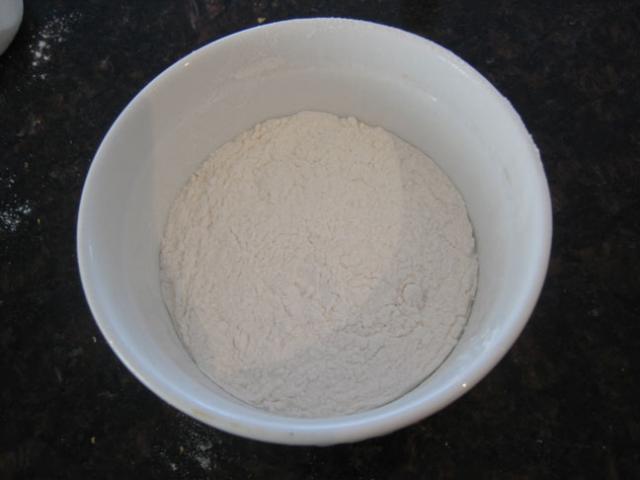
Here it is at 50 minutes (the white flour on the left is raw to compare the difference):
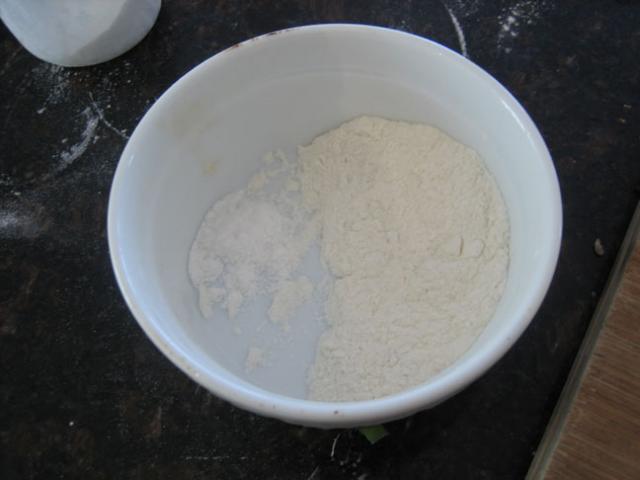
Here it is at 1:05:
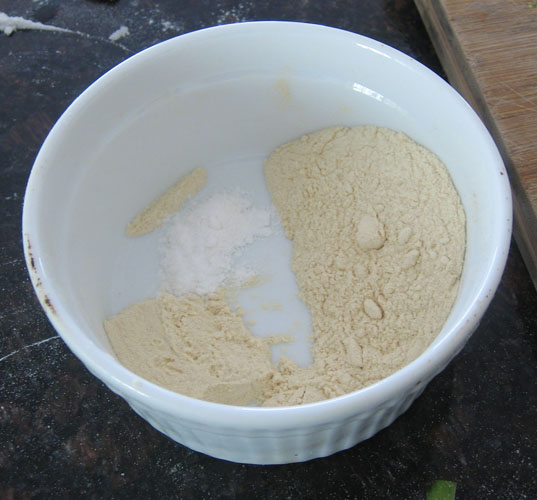
And here it is at 1:25:
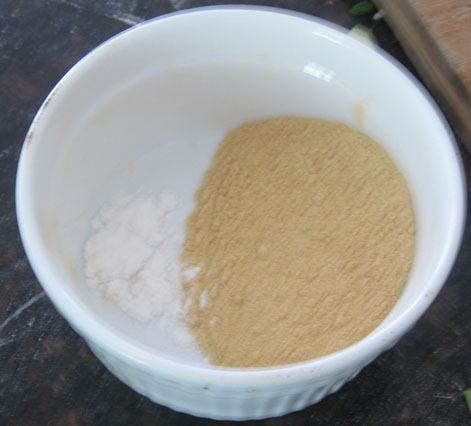
As you can see, it starts off slow and then browns relatively quickly. Browning seems to be even. Here is a close up:
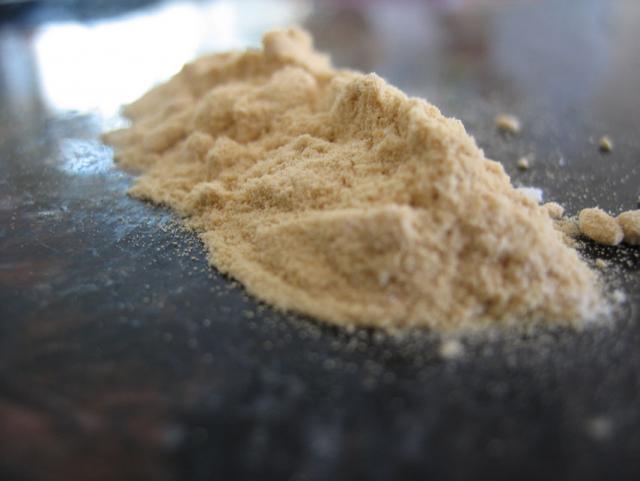
-
Compound butter will keep for a week or more easy so make it a few days before hand and try it out on something. If you like it, then your stress free on the night, if you don't then try another recipe.
-
Cornstarch has different thickening powers to wheat starch. And I don't see why it's neccesary to bind it into a paste. You can thicken liquids by just mixing raw flour with cold water and heating except you supposedly get a raw flour taste and none of the browning.
In fact, unless theres a marked flavour difference, I can't see the disadvantage to the fat free method. With the normal method, it's sometimes hard to judge how much roux you need since a darker roux thickens less. Often, your left with a liquid thats too thick or too thin. With the fat free method, you can make a huge batch all at once and keep it in your pantry and then just thicken as you go along until you reach the right consistency. If you really want the butter/bacon fat/whatever flavour, theny you can add it as well.
I'll try an experiement when I have time to see if it works as promised.
-
The purpose of making a roux is to brown the flour in hot fat so that the "raw" taste is cooked out and brown flavours are developed. However, the same effect could presumably be achieved without any fat by, say, toasting it in a low oven until it's equally browned and then mixing with water to form a slurry. Searching on the web, I've found a couple of references to doing this but it doesn't seem to be too common.
It seems to me that this would be a no-brainer for anybody on a low fat diet. You can cook large batches of flour at once and it apparently keeps for at least 6 months. Is there some hidden drawback to this approach? Does it not taste the same? Is it too much work?
-
For the tuna, I'm thinking a little white miso and sesame seed oil and mirin blended together with a neutral oil.
Alton Brown recently made an Avacado Compound Butter that sounds... interesting....
-
Had a quick browse through it. It looks good but not $70 good
 .
. -
-
You want an excessive menu, try Shopsins, the place Calvin Trillian has written about in New York.
The scary thing is that most things are pretty good (certainly not everything, but most things) and the menu changes regularly. About every other visit I either ask about something that is gone or order something that the staff comments is new.
Oh gawd, that thing is horrendous.
-
No such luck. That was pre-digital camera days. It was so weird that I have threatened to duplicate it, partly to get that amazing picture, and partly to play a practical joke on my kids or nephew. The idea is to just serve it up without comment that there is anything strange and see how they react.

The collective denizens of the Dinner II thread demand it!

-
I think it has to do with the fact that unsalted wine has an extra alcohol tax placed on it since it's classified as a beverage while the salted kind is presumably considered a food additive.
-
Imagine what would happen if someone posted 3+3 = 5? We would get corrected, and how.
Thats silly... Everyone knows that .it's 2 + 2 = 5
 .
.Seriously though humans are notorious for grossly overestimating the likleyhood and severity of rare errors while grossly underestimating the severity and likelyhood of common errors. Which is why more people have a fear of flying than a fear of driving, even though the drive to the airport is more dangerous than your plane trip.
Even if the risks of BGH were real, the fact that it's taken so long to pick them up must mean they are incredibly subtle. Hardly something worth worrying about while other, very real and significant risks are ignored.
-
We had some left over kelp & cabbage soup broth and I love doing fusion style risottos so I made a risotto with beef, leek spring onions & nori:

A dash of mirin and sugar to give it a japanse twist.
It was very good.
-
Pringles are made from a paste of potato starch, extruded into a shape and then dehydrated and powdered IIRC. Probably not practical at home. Lays style chips are easy as long as you have a mandolin. Just set it to the thinnest setting and slice. Rinse in cold water and then place between two paper towels to absorb the moisture. A quick dip into 375F oil (tallow is preferred if you can get it, otherwise, canola oil) until they are crisp and then place on some more paper towels and sprinkle with a little fleur de sel.
-
I've sadly been forced to give up my animal fat obsession as of late due to an ever expanding waistline but the one small concession I will make is that I take the fat from off the top of the drippings of a roast chicken and use it to make the most utterly divine salad dressing in the world. I figure the goodness of the lettuce is enough to balance the badness of all that cholesterol.




Dinner II: The Gallery of Regrettable Foods (Part 1)
in Cooking
Posted
Any takers?